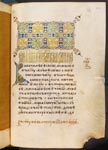Tetraevangelion.
15th cent. Scribe: Christopher (?)
F (265 ı 185). 303+II leaves.
Parchment. Ink, cinnabar, colours, gold.
It is written in calligraphic semi-uncial by two hands.
The manuscript contains head-pieces in the Balkan style with motifs of intersected circles and polygons and large initials in colours and gold (fols. 7r, 87r, 139r, 226r); protective silk curtains are placed before head-pieces (one preceeding fol. 139r is now lacked). Folios 289r has a head-piece in the form of a bar in the Balkan style. Headings at the starts of the Gospels are written in gold with use of ligatures. The rest of headings and initials are in cinnabar.
Folios 302 bears the scribe's inscription, which contains his monogram consisting of letters "Chr".
Most researchers assume that the monogram may have signed "Christopher". This assumption allows Gerold Vzdornov to suppose that the Gospel was copied by Christopher, a pupil of Saint Kirill of Beloozero, the third hegumen of the Kirillo-Belozersky Monastery who was the head of the Monastery in 1428-1434. In the 60s of the 15th century, the Serb Pakhomy Logophet in the Life of Saint Kirill of Beloozero states that Christopher was a skilled calligrapher who copied a great number of books. The Gospel was copied onto splendidly prepared parchment in professional scripts and richly decorated with gold. The illumination of the manuscript reveals the subtle artistic flair of its creators. The luxurious Gospel is an evidence of excellent workmanship of the copyists.
In 1918 the manuscript came into the State Public Library along with the other materials from the library of the Kirillo-Belozersky Monastery, transferred from the St Petersburg Theological Academy.
Shelfmark: –Õ¡. Ë.-¡ÂÎ. 2/2.





